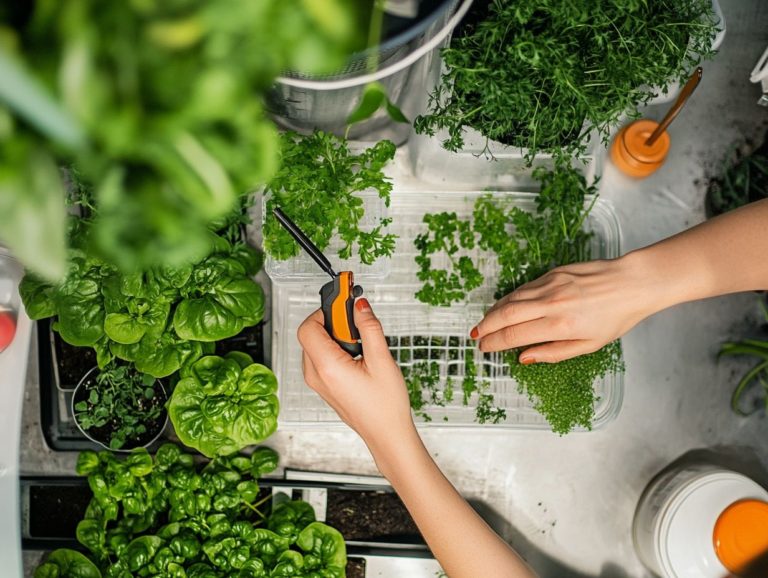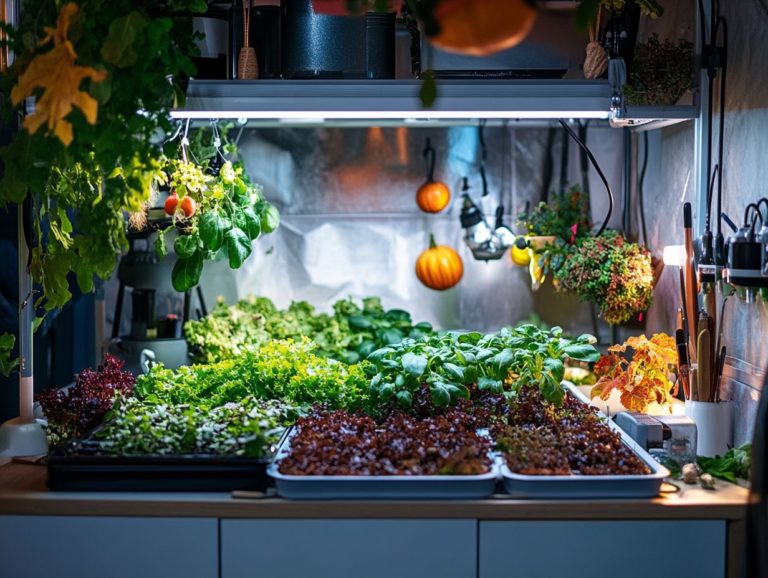Best Practices for Hydroponic System Setup
Hydroponics is revolutionizing the way you grow plants, providing a soil-free method that optimizes both space and resources.
This article explores different hydroponic systems. You ll discover how to set up your own system step by step, including the essential components and maintenance tips that will keep everything running smoothly.
Common issues you might encounter will be addressed, along with effective strategies to enhance plant growth. Whether you re just starting out or looking to refine your skills, this guide has valuable insights tailored for you.
Contents
- Key Takeaways:
- Types of Hydroponic Systems
- Setting Up a Hydroponic System
- Maintaining a Hydroponic System
- Troubleshooting Common Issues
- Tips for Maximizing Plant Growth
- Frequently Asked Questions
- What are the best practices for setting up a hydroponic system, including nutrient management?
- How do I choose the right location for my hydroponic system setup?
- What materials should I use for my hydroponic system setup?
- Why is it important to maintain proper water and nutrient levels in a hydroponic system?
- Do I need to sterilize my equipment before setting up a hydroponic system?
- How often should I clean and maintain my hydroponic system?
Key Takeaways:

- Discover the exciting world of hydroponics and the different types of systems available for growing plants without soil.
- Acquire the necessary components and follow a step-by-step setup process to properly install a hydroponic system.
- Regularly maintain and troubleshoot common issues to ensure the best possible growth for your plants in a hydroponic system.
What is Hydroponics?
Hydroponics presents an innovative growing method that allows you to cultivate plants without soil, relying instead on a nutrient-rich water solution that provides all the essential elements for plant health. This technique enhances your crop production by letting you precisely control nutrient levels, water quality, and environmental factors.
It s no wonder gardening enthusiasts are flocking to hydroponics to maximize yields while conserving precious water resources.
Dating back to ancient civilizations that practiced early forms of soilless agriculture, hydroponics has undergone significant evolution, especially in recent decades. Its benefits go beyond mere convenience; it promotes faster growth rates, superior quality produce, and fewer pest issues, aligning perfectly with the demands of modern agriculture.
From vertical farms in bustling urban environments to advanced greenhouses, the applications of hydroponics are vast and varied. As climate change introduces new challenges to traditional farming, this method is increasingly recognized as a sustainable solution that appeals not only to commercial growers but also to hobbyists eager to delve into efficient gardening practices.
Types of Hydroponic Systems
You ll discover a variety of hydroponic systems, each specifically designed to cater to specific crop requirements and enhance plant growth.
Among these options are the aeroponic system, Deep Water Culture (DWC), and Nutrient Film Technique (NFT), each offering unique advantages tailored to your gardening aspirations.
Comparison of Different Systems
It s exciting to explore how each system manages nutrients and supports plant health! When comparing various hydroponic systems, evaluate their efficiency in managing nutrient solutions, crop production, and the overall environment they create for plant root systems.
Take aeroponic setups, for example. They use misting techniques to provide optimal oxygenation and nutrient uptake for the roots, potentially leading to superior yields. On the flip side, Deep Water Culture (DWC) allows roots to bask in nutrient-rich water, offering a steady supply of essential elements. However, it requires diligent monitoring to mitigate risks like root rot. If you’re interested in exploring more about hydroponics, you can check out this guide on how to build a simple hydroponic system.
Then there s the Nutrient Film Technique (NFT), which continuously flows nutrient solution over the roots, ensuring efficient resource use. Yet, it demands precise management to maintain a balanced nutrient profile.
By understanding the costs linked to setup, maintenance, and potential crop outputs, you can identify the most viable options for both small-scale and commercial growers.
Setting Up a Hydroponic System
Ready to set up a hydroponic system? Let s start with the essential components you’ll need for success. This includes mastering proper reservoir water management and employing transplantation techniques that promote robust root systems and optimal plant growth.
Key Components and Equipment

The key components and equipment of a hydroponic system are essential for your success. You’ll need air pumps, various growing mediums, and light sources to guarantee that your plants receive the optimal light intensity for growth.
Nutrient reservoirs are critical. They store the essential solutions that nourish your plants. You should also invest in pH and EC (electrical conductivity) meters. These tools help you monitor and maintain the ideal nutrient levels, which is crucial for plant health.
Timers are essential for regulating light exposure, simulating the natural day-night cycles that foster healthy photosynthesis. Water pumps circulate nutrient solutions, ensuring even distribution and preventing stagnation.
Every piece of equipment is thoughtfully designed with the health and vitality of your plants in mind, making it easier for you to cultivate a productive and thriving hydroponic environment.
Step-by-Step Setup Process
The step-by-step setup process for your hydroponic system begins with selecting the right equipment, preparing an ideal nutrient solution, and making those essential pH adjustments to cultivate an optimal growing environment for your plants.
- Choose a hydroponic system type that suits your needs whether it’s Deep Water Culture, Nutrient Film Technique, or Ebb and Flow based on your available space and the crops you wish to grow. For more details on Deep Water Culture, check out this guide on how to set up a deep water culture system.
- Once you’ve established the structure, you’ll need to mix the nutrient solution tailored to the specific requirements of your chosen plants, as different species flourish with varying nutrient concentrations.
- Utilizing a pH meter will be invaluable in ensuring the pH stays within the ideal range of 5.5 to 6.5, which promotes effective nutrient absorption.
Regularly maintaining your system is crucial for maximizing your plant growth! Make it a habit to check the reservoir water levels, clean out any algae or buildup, and continuously monitor nutrient levels, adjusting them as needed to meet the dynamic requirements of your plants throughout their growth cycle.
Maintaining a Hydroponic System
Maintaining a hydroponic system is essential for ensuring the health of your plants and optimizing crop production. You’ll need to engage in regular monitoring of critical environmental factors, such as water quality and nutrient levels, to achieve the best results.
Proper Care and Maintenance
Proper care and maintenance of your hydroponic system require you to monitor water temperature, ensure oxygen availability, and regularly check root health. Paying attention to details ensures your plants thrive!
This careful management is essential because plants depend on optimal conditions for nutrient uptake. Maintaining the right water temperature is key, as it helps facilitate this process and prevents stress that could stunt growth. Incorporating air stones or pumps can significantly boost oxygen levels in your nutrient solution, allowing the roots to absorb essential nutrients more efficiently. Additionally, understanding how to maintain your hydroponic growing system can further enhance plant health and productivity.
The ideal temperature range not only influences root health but also impacts overall plant metabolism and productivity. By prioritizing these specific techniques, you can cultivate a more effective hydroponic system, ultimately leading to healthier plants and bountiful yields.
Troubleshooting Common Issues
Troubleshooting common issues in a hydroponic system demands your keen understanding of nutrient solution management, along with the ability to identify potential problems that could impede plant growth.
By honing these skills, you position yourself to effectively nurture your plants and optimize their health in this innovative growing environment. Start monitoring today to keep your hydroponic setup thriving!
Identifying and Solving Problems

Identifying and addressing issues within your hydroponic system is crucial for maintaining the health of your crops. Problems with nutrient levels or environmental factors can quickly derail plant growth. Therefore, vigilance is key.
Regular monitoring is essential. Even minor imbalances can lead to nutrient deficiencies or toxicities, showing up as yellowing leaves or stunted growth. Use methods like pH testing and electrical conductivity (EC) measurements to ensure your nutrient solutions meet your crops’ needs.
By adjusting nutrient concentrations based on these readings, you can nip potential issues in the bud before they escalate. Establish a comprehensive maintenance schedule, complete with regular reservoir cleaning and timely solution changes. Additionally, learning how to optimize your hydroponic layout will help minimize the risk of pathogens and nutrient build-up, ultimately fostering healthier and more productive plants.
Tips for Maximizing Plant Growth
To truly maximize plant growth in your hydroponic system, concentrate on fine-tuning nutrient levels, adjusting light intensity, and ensuring optimal oxygen availability. Tailor these factors to the specific type of system you are using.
Optimizing Nutrient Levels and Lighting
Optimizing nutrient levels and lighting means crafting a balanced nutrient solution and ensuring your growing medium gets all the light it needs for optimal plant photosynthesis.
To achieve this, mix macro and micronutrients with care. Adjust the ratios to meet the specific needs of your crops. Regularly monitor pH levels and electrical conductivity (EC) to maintain nutrient balance, fostering healthy root development. If you encounter issues, refer to this guide on how to troubleshoot common hydroponic issues.
Investing in the right lighting systems, like LED grow lights, is crucial. They not only provide the perfect spectrum for photosynthesis but also enhance energy efficiency. Position these lights at optimal distances to prevent heat stress while ensuring every part of your plants receives ample illumination.
By combining these strategies, you create an environment that promotes robust crop health and maximizes yield.
Frequently Asked Questions
What are the best practices for setting up a hydroponic system, including nutrient management?
Some best practices include choosing the right location, using high-quality materials, maintaining proper water and nutrient levels, and sterilizing your equipment properly.
How do I choose the right location for my hydroponic system setup?

The ideal location is a well-ventilated area with access to natural light or artificial grow lights. It should also have a stable temperature, away from drafts and extreme heat or cold.
What materials should I use for my hydroponic system setup?
Use high-quality, food-grade materials such as PVC pipes, plastic containers, and rubber tubing. Avoid materials that may leach harmful chemicals into the water, affecting plant growth.
Why is it important to maintain proper water and nutrient levels in a hydroponic system?
Maintaining proper water and nutrient levels is crucial for your plants’ health and growth. Too much or too little can lead to root rot, nutrient deficiencies, and stunted growth.
Do I need to sterilize my equipment before setting up a hydroponic system?
Yes! Sterilizing your equipment helps prevent the growth of harmful bacteria and fungi that can harm your plants and affect their growth.
How often should I clean and maintain my hydroponic system?
Make sure to clean and maintain your system regularly at least once a week. This includes checking and adjusting water and nutrient levels, removing dead or diseased plants, and cleaning the equipment to prevent algae or other contaminants.






